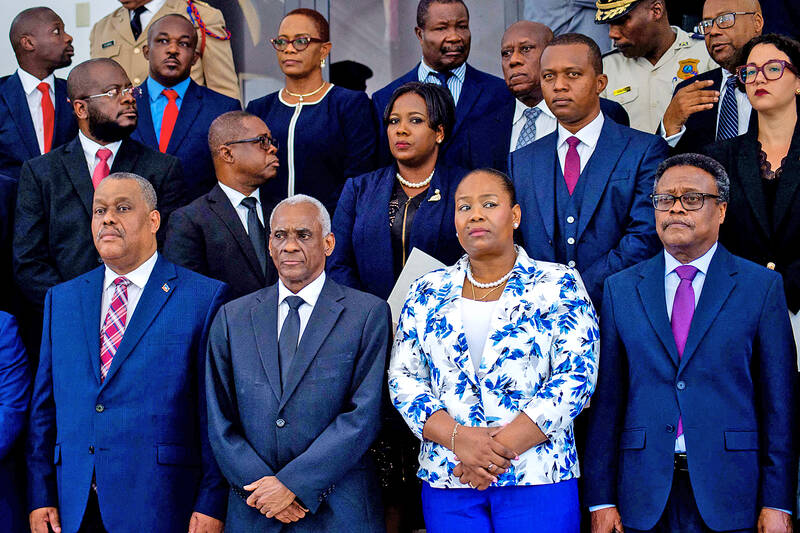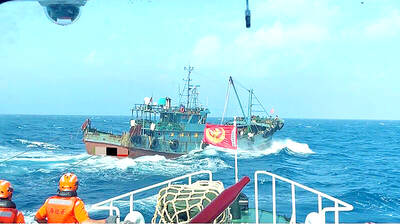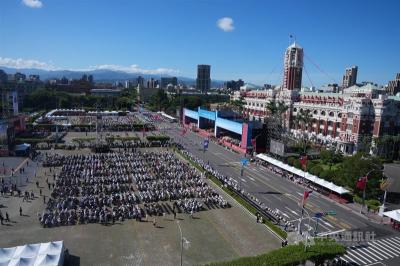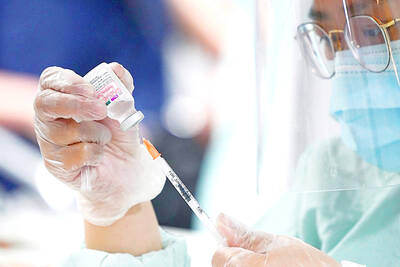Haiti’s transitional council on Tuesday appointed a new Cabinet, marking the final step in rebuilding the government that is to lead a country under siege by gangs.
Government spokeswoman Kettia Marcellus confirmed the existence of the new Cabinet and its ministers.
Carlos Hercules, the attorney for Haitian Prime Minister Garry Conille, was appointed as minister of justice and public security. Conille himself is to be interior minister. Jean Marc Berthier Antoine is to be defense minister.

Photo: AFP
Haiti struggles with gangs that control at least 80 percent of the capital, Port-au-Prince. It is preparing for the UN-backed deployment of a police force from Kenya expected in the next few weeks.
Weeks of coordinated attacks by gangs forced former Haitian prime minister Ariel Henry to resign in April and his Cabinet was dissolved.
Gunmen took control of police stations, opened fire on the main international airport that remained closed for nearly three months and stormed prisons.
More than 2,500 people were killed or injured in the first three months of the year and more than half a million others displaced.
Conille has pledged to crack down on the violence.
Dominique Dupuy, a UNESCO ambassador who was once a member of the transitional council before resigning, is to be foreign affairs minister.
She resigned in part because of political attacks and death threats.
Others in the new Cabinet include Ketleen Florestal, who is to be minister of economy and finance.
One thing that stands out about many of the ministers appointed to the new Cabinet is the relative obscurity of their names, said Michael Deibert, author of Notes From the Last Testament: The Struggle for Haiti and Haiti Will Not Perish: A Recent History.
“There is a smattering of people with international experience ... but still, there are not a lot of immediately recognizable high-level names from within Haitian politics,” he said. “Some people might think that’s a good thing.”

POLITICAL AGENDA: Beijing’s cross-strait Mid-Autumn Festival events are part of a ‘cultural united front’ aimed at promoting unification with Taiwan, academics said Local authorities in China have been inviting Taiwanese to participate in cross-strait Mid-Autumn Festival celebrations centered around ideals of “family and nation,” a move Taiwanese academics said politicizes the holiday to promote the idea of “one family” across the Taiwan Strait. Sources said that China’s Fujian Provincial Government is organizing about 20 cross-strait-themed events in cities including Quanzhou, Nanping, Sanming and Zhangzhou. In Zhangzhou, a festival scheduled for Wednesday is to showcase Minnan-language songs and budaixi (布袋戲) glove puppetry to highlight cultural similarities between Taiwan and the region. Elsewhere, Jiangsu Province is hosting more than 10 similar celebrations in Taizhou, Changzhou, Suzhou,

COGNITIVE WARFARE: Chinese fishing boats transmitting fake identification signals are meant to test Taiwan’s responses to different kinds of perceived incursions, a report said Chinese vessels are transmitting fake signals in Taiwan’s waters as a form of cognitive warfare, testing Taipei’s responses to various types of incursions, a report by the Institute for the Study of War said on Friday. Several Chinese fishing vessels transmitted fake automatic identification system (AIS) signals in Taiwan’s waters last month, with one mimicking a Russian warship and another impersonating a Chinese law enforcement vessel, the report said. Citing data from Starboard Maritime Intelligence, the report said that throughout August and last month, the Chinese fishing boat Minshiyu 06718 (閩獅漁06718) sailed through the Taiwan Strait while intermittently transmitting its own AIS

The Republic of China (ROC) is celebrating its 114th Double Ten National Day today, featuring military parades and a variety of performances and speeches in front of the Presidential Office in Taipei. The Taiwan Taiko Association opened the celebrations with a 100-drummer performance, including young percussionists. As per tradition, an air force Mirage 2000 fighter jet flew over the Presidential Office as a part of the performance. The Honor Guards of the ROC and its marching band also heralded in a military parade. Students from Taichung's Shin Min High School then followed with a colorful performance using floral imagery to represent Taiwan's alternate name

CHINESE INFILTRATION: Medical logistics is a lifeline during wartime and the reported CCP links of a major logistics company present a national security threat, an expert said The government would bolster its security check system to prevent China from infiltrating the nation’s medical cold chain, a national security official said yesterday. The official, who wished to stay anonymous, made the remarks after the Chinese-language magazine Mirror Media (鏡周刊) reported that Pharma Logistics (嘉里醫藥物流) is in charge of the medical logistics of about half of the nation’s major hospitals, including National Taiwan University Hospital and Taipei Veterans General Hospital. The company’s parent, Kerry TJ Logistics Co (嘉里大榮物流), is associated with the National Committee of the Chinese People’s Political Consultative Conference (CPPCC) and the Chinese People’s Liberation Army (PLA), the